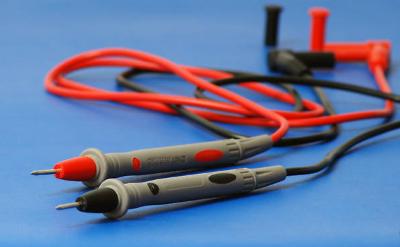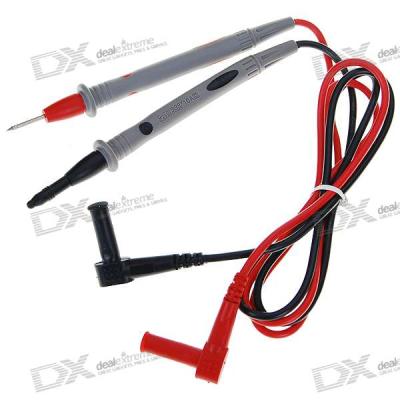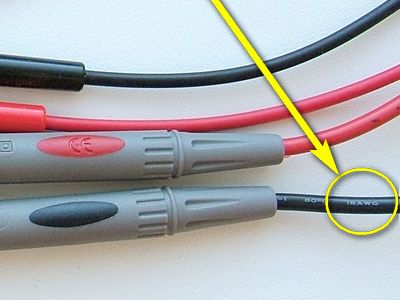eBay Dispute Avoided
Last year, I wound up in an eBay dispute with a seller who was eventually banned (read it here). This time I was looking for some heavy duty leads for my voltmeter (really a Digital Multimeter or DMM). The problem is I was getting bad readings of amps on my voltage meter while measuring the current draw of a flashlight. After comparing the result to a friend's DMM, I knew mine was off. His meter had thick leads and the wire said 18AWG on them. If I used his leads on my meter, I got more reasonable results. The leads on my other DMM (which doesn't measure current) say 26AWG and look similar to the ones on the DMM that measures amps. 18 gauge wire is 1.024mm thick while 26 gauge wire is only 0.405mm thick. But the area of the 18 gauge wire is 6 times greater. Therefore the resistance in the skinnier wire is 6 times more than in the thicker wire and that is what was messing up the readings.
So I went looking for leads. After doing some searching I found two sources: eBay and DealExtreme (the place I buy a lot of flashlights). Both sets looked identical, with gray probes described as 10 Amp leads.


I figured they were the same thing. However, I think both are just knock-offs of much more expensive leads by a company named Fluke.
Neither ad said what gauge wire was being used, which would have been a lot more helpful. But looking more closely at the ones at DX, I noticed a user-submitted photo of the leads which had enough resolution to show 18AWG! Perfect.

On eBay the leads were coming from Canada so if I could get them cheaply (it was a real auction) then I could have them faster without paying much more than the the leads at DX ($3.01), even including the $1.99 shipping for the eBay ones (DX ships free). So I put in a bid of $1.13, but I was beat and the leads went for $1.38. The seller had auctions for these leads every few days, but I didn't want to wait and sometimes the leads would go for more like $5-6 when people really bid each other up. The DX leads seemed like more of a sure thing and although they would take about 3 weeks to get here, I went ahead and placed an order. The listing at DX says the item ships in 4-7 business days, but after ordering they showed In Stock. However after a week, they were Waiting on Supplier. I gave them the 7 working days and then went back to eBay. I put in a bid again, this time for $1.23. This time I won, beating out someone who had bid $1, but eBay tried to add the 25 cent next bid increment except I had only bid $1.23, so I could have won the bid with $1.01. I paid immediately and then canceled my DX order. The seller gave me positive feedback, but they didn't ship the item for 4 days and it took about a week to get the leads. When I got them, there was no writing on the wires and, although they were thick, they seemed a little too flexible. I measured the current on my flashlight and got the same low reading as I did with the original leads. These must be 26 AWG also. I immediately placed a new order for the DX leads (they had just given me my money back a couple of days earlier) and hoped I would get the same 18AWG leads the earlier user had received (there's no guarantee with DX, they change suppliers and specifications without notice). I also left a negative review with the eBay seller saying his shipping was kind of slow and the item was not as described, unable to measure even 2 amps rather than 10 amps. I wasn't going to bother with a dispute over something that cost $3, primarily because I didn't want to have to pay to mail the item back to Canada. However the leads were useless and just to prove to myself that I was right, I cut away some of the insulation. I found that the leads were almost all insulation with a tiny core of copper wire. In fact later on I stripped off some more insulation, twisted the copper and measured it with my digital calipers and backfigured they were about 26 gauge.

This is where it gets interesting (well, really you have to admit the whole thing is fascinating). The next day I get a message from the seller saying that he was not aware of problems with the leads, but he cut some open anyway and found the wire was pretty thin. He said he also cut open some Fluke leads and they were a little thicker. He said he would give me my money back and send me a pair of his 20 amp leads (not available through auction, they sell for $7.99) which he said had about 10 times as much wire in them if I would take away my negative feedback. This is a guy with 99.9% positive feedback and I was impressed he was willing to do all of this to make me happy. Plus I would be getting $7.99 leads for free! Of course I agreed, but I told him he should advertise the wire gauge of his leads since the amps don't really mean anything. I never got a response to the e-mail, but I did get the new leads a week later.
The new leads are definitely thicker and less flexible. I am not 100% convinced they are 18 AWG (no writing on these either), but I am measuring 2.1 amps now instead of 1.5 amps with the other leads (the true current should be around 2.8 amps, but the battery itself may not be able to supply that much current).
I'm still waiting on the ones I ordered in haste from DX. However a second set of leads can still be useful for me.
Here are the leads I wound up building later on (see comment below):

Comments (3)
re: "(well, really you have to admit the whole thing is fascinating)"
Cut open the new ones so we can see them side-by-side!!!
Posted by Jeb | August 15, 2010 7:19 PM
I got the DX leads today. They do say 18AWG on them, but they don't seem any heavier duty than the 20 amp leads (the DX leads say 10A on them). However, in testing the current from the battery to the LED, the DX leads measure 2.3A and the eBay leads give 2.0A.
A guy on one of the flashlight boards says you can make a lead out of a piece of romex (house wiring) and a resistor, so I might look into that. I'm also going to charge these batteries and see if I get a higher reading.
Posted by Ted | August 17, 2010 8:17 PM
I finally resolved the issue of the leads. The improved eBay leads were still pretty lousy and the DX leads, while better, still weren't reading properly when currents were over 2 amps. And with the Cree XM-L LED, which can easily take 3 amps, I need to be able to take higher current readings. I bought some banana plugs at Fry's which would fit into the jacks on the DMM, and tried to attach some solid (not stranded) copper wire for home wiring (12 AWG, 2mm diameter and 3.31mm² of area!) but couldn't figure out a way to attach it to the plugs I bought. It seemed like the plugs were really meant for stranded wire like you might have for speaker cables, though I couldn't spare any speaker cable and I don't think it is thick enough anyway, despite being about the same thickness as a lamp cord. Months passed and I was needing to run some high current flashlight tests. I figured I could probably use some wire from a heavy duty extension cord, but I didn't want to ruin any of mine. Then I thought I probably had some power cords for computers lying around that I could use. I went back in my junk room and found a cord that had been partially chewed up by the puppy I had earlier this year, so it was already ruined and the wire looked pretty thick. Based on a measured diameter of just over 1.2mm, I'm thinking it is 16 AWG (1.31mm² of area, or 60% more than 18 AWG; well, actually I just took another look at what is left of that cord and the writing on it indicates 18 AWG, though I have a heavy duty orange extension cord that indicates 16 AWG). Also, since resistance increases with the length of the wire and all my store-bought leads are 1 meter long, I was able to cut resistance by 90% by cutting the wire to only 10cm long which is still long enough for what I'm doing. I stripped some insulation around the end and applied some solder to get a nicely silvered probe end. Now I am able to get a proper reading of about 2.8A from a light that I know should pull that amount. And I found that a light I just bought was pulling 3.3A!
Posted by Ted | October 29, 2011 10:53 PM